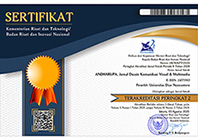Tinjauan Tampilan Visual Desain Kemasan Roti Murni di Yogyakarta
DOI:
https://doi.org/10.33633/andharupa.v2i02.1205Abstract
AbstrakKemasan pada saat ini telah mengalami penambahan fungsi dimana kemasan tidak lagi sekedar untuk melindungi dan sebagai wadah, tetapi juga berfungsi sebagai media promosi serta komunikasi sebuah produk. Kini desain kemasan telah menjadi bagian penting dalam proses pemasaran. Penelitian ini mengambil objek kajian kemasan Roti Murni di Yogyakarta yang sudah lama tidak mengalami perubahan desain kemasannya. Tujuan dari penelitian adalah untuk mengetahui latar belakang desain kemasan Roti Murni yang sudah lama tidak mengalami perubahan dan meninjau kemasan kardus Roti Murni dengan teori kemasan Desain Komunikasi Visual. Metodologi penelitian kualitatif digunakan dengan sumber data yang diperoleh dengan cara observasi dan wawancara. Data penelitian kemudian dianalisis dengan teknik analisis komponensial menggunakan teori warna, bentuk, ilustrasi, tipografi, dan tata letak menurut Desain Komunikasi Visual. Dari hasil penelitian ditemukan fakta yang menarik bahwa kemasan Roti Murni tidak berubah karena perusahaan tidak memiliki desainer kemasan, dan desain kemasannya tidak secara keseluruhan sesuai dengan teori DKV. Kata kunci: Kemasan, Roti Murni, Tampilan Visual, Yogyakarta  AbstractPackaging at this time is indicating to have some additional functions where the packaging is no longer simply to protect or just as a container of a product inside, but also serves as a media campaign of a product inside. Packaging design then has become an important part of the marketing process. The object of this study is the packaging design used by “Roti Murniâ€, one of bakery companies in Yogyakarta. The packaging design used by “Roti Murni†has been known that it has not been changed since long time ago. The purpose of the study is to determine the background of “Roti Murni†packaging design that has not changed and to review the design of the packaging with the theory of Visual Communication Design. This study is using qualitative research methodology, while the source data analized were obtained by observation and interviews. Data were analyzed with componential analysis techniques using the theory of color, shape, illustration, typography, and layout in Visual Communication Design. The research found an interesting fact that the packaging of “Roti Murni†has not changed since the company does not have packaging designers, and the overall packaging design itself was not designed by using the theory of Visual Communication Design. Keywords: Packaging, Murni Bakery, Visual Review, YogyakartaReferences
Bungin, Burhan.2007.Penelitian Kualitatif Komunikasi, Ekonomi, Kebijakan Publik, dan Ilmu Sosial Lainnya Edisi Kedua.Jakarta: Prenada Media Group.
Danger, EP. 1992.Memilih Warna kemmasan.Jakarta;Institut PPM
Julianti, Sri.2014.The Art of Packaging. Jakarta: PT Gramedia Pustaka Utama.
Klimchuk, Marianne Rosner dan Krasovec, Sandra A. 2006. Desain Kemasan: Perencanaan Merek Produk yang Berhasil Mulai dari Konsep sampai Penjualan. Jakarta: Erlangga.
Rustan, Surianto.2009. Mendesain Logo. Jakarta: PT Gramedia Pustaka Utama.
Wirya, Iwan.1999. Kemasan yang Menjual. Jakarta: PT Gramedia Pustaka Utama.
Cenadi, Christine Suharto.2000. Peranan Desain Kemasan Dalam Dunia Pemasaran. NIRMANA. Vol 2:92-103.
Lakoro, Rahmatsyam.2002.Studi Komunikasi Visual Pada Kemasan Makanan Ringan. (http://personal.its.ac.id/files/pub/.pdf diakses 9 Mei 2016 pukul 10.45 WIB)
Natadjaja, Listia.2007. Analisa Elemen Grafis Desain Kemasan Indomie Goreng Pasar Lokal dan Ekspor. NIRMANA.Vol 9:20-30.
Prathama, Nico Yudha dan Setianto, Dodi. 2015.Analisis Elemen Visual Kemasan Chiki Snack. Dimensi. Vol 12:241-252.
Downloads
Published
Issue
Section
License
Copyright (c) 2016 ANDHARUPA: Jurnal Desain Komunikasi Visual & Multimedia

This work is licensed under a Creative Commons Attribution 4.0 International License.
Authors who publish with this journal agree to the following terms:
- Authors retain copyright and grant the journal right of first publication with the work simultaneously licensed under a Creative Commons Attribution License that allows others to share the work with an acknowledgment of the work's authorship and initial publication in this journal.
- Authors are able to enter into separate, additional contractual arrangements for the non-exclusive distribution of the journal's published version of the work (e.g., post it to an institutional repository or publish it in a book), with an acknowledgment of its initial publication in this journal.
- Authors are permitted and encouraged to post their work online (e.g., in institutional repositories or on their website) prior to and during the submission process, as it can lead to productive exchanges, as well as earlier and greater citation of published work (See The Effect of Open Access).















